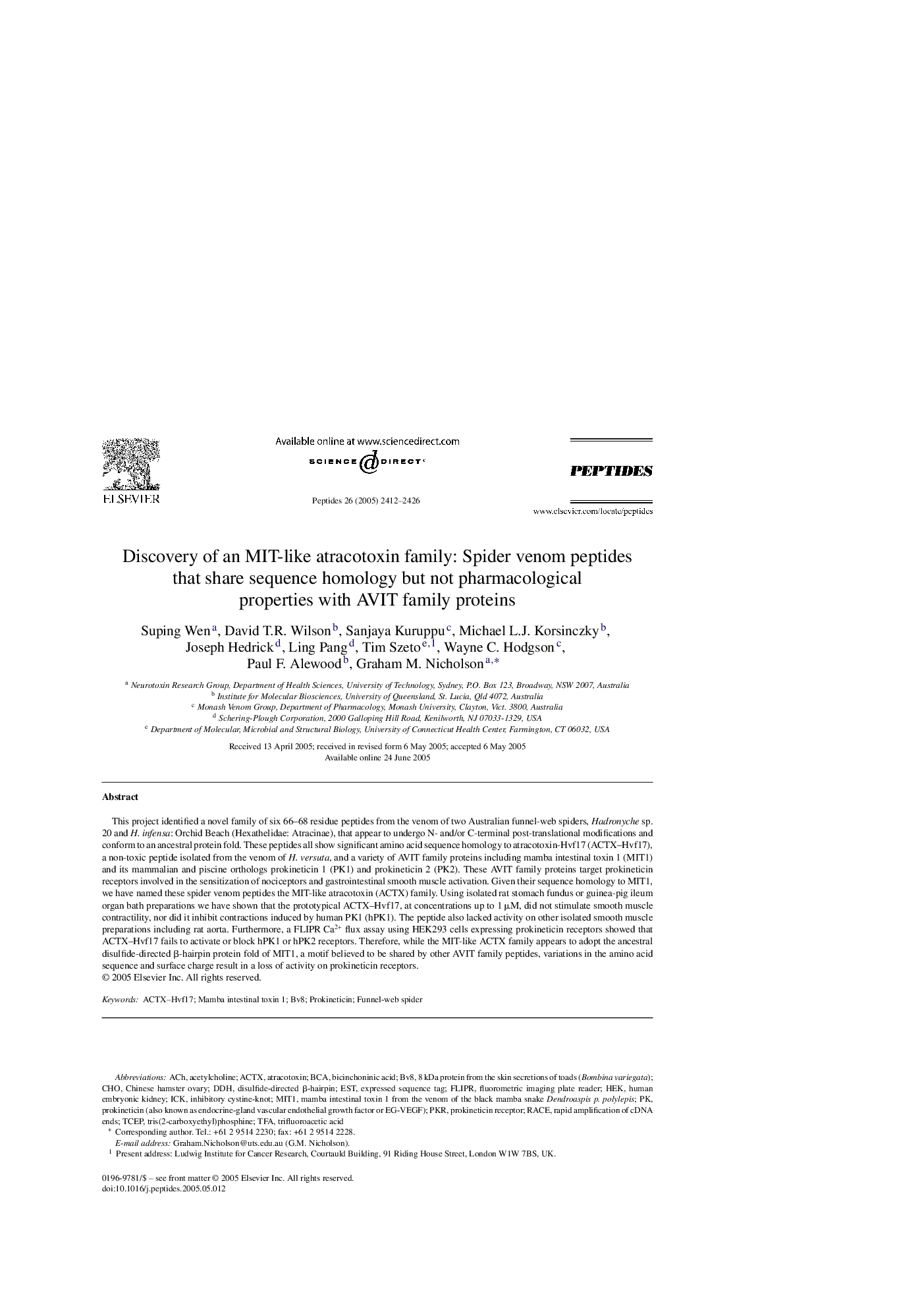| کد مقاله | کد نشریه | سال انتشار | مقاله انگلیسی | نسخه تمام متن |
|---|---|---|---|---|
| 2008685 | 1066439 | 2005 | 15 صفحه PDF | دانلود رایگان |
عنوان انگلیسی مقاله ISI
Discovery of an MIT-like atracotoxin family: Spider venom peptides that share sequence homology but not pharmacological properties with AVIT family proteins
دانلود مقاله + سفارش ترجمه
دانلود مقاله ISI انگلیسی
رایگان برای ایرانیان
کلمات کلیدی
PKRatracotoxinFunnel-web spiderBv8Prokineticin receptorICKFLIPRDDHTFAHEKBCAtris(2-carboxyethyl)phosphine - tris (2-carboxyethyl) فسفینACh - آهEST - استAcetylcholine - استیل کولینTrifluoroacetic acid - اسید TrifluoroaceticCho - برایbicinchoninic acid - بیسینکنینیک اسیدChinese Hamster Ovary - تخمدان هامستر چینیrapid amplification of cDNA ends - تقویت سریع cDNA به پایان می رسدExpressed Sequence Tag - تکرار اظهار نظرTCEP - ساکتFLuorometric Imaging Plate Reader - فلورومتریک تصویربرداری صفحات خوانندهRace - مسابقهProkineticin - پروکینتیکینhuman embryonic kidney - کلیه جنین انسان
موضوعات مرتبط
علوم زیستی و بیوفناوری
بیوشیمی، ژنتیک و زیست شناسی مولکولی
زیست شیمی
پیش نمایش صفحه اول مقاله

چکیده انگلیسی
This project identified a novel family of six 66-68 residue peptides from the venom of two Australian funnel-web spiders, Hadronyche sp. 20 and H. infensa: Orchid Beach (Hexathelidae: Atracinae), that appear to undergo N- and/or C-terminal post-translational modifications and conform to an ancestral protein fold. These peptides all show significant amino acid sequence homology to atracotoxin-Hvf17 (ACTX-Hvf17), a non-toxic peptide isolated from the venom of H. versuta, and a variety of AVIT family proteins including mamba intestinal toxin 1 (MIT1) and its mammalian and piscine orthologs prokineticin 1 (PK1) and prokineticin 2 (PK2). These AVIT family proteins target prokineticin receptors involved in the sensitization of nociceptors and gastrointestinal smooth muscle activation. Given their sequence homology to MIT1, we have named these spider venom peptides the MIT-like atracotoxin (ACTX) family. Using isolated rat stomach fundus or guinea-pig ileum organ bath preparations we have shown that the prototypical ACTX-Hvf17, at concentrations up to 1 μM, did not stimulate smooth muscle contractility, nor did it inhibit contractions induced by human PK1 (hPK1). The peptide also lacked activity on other isolated smooth muscle preparations including rat aorta. Furthermore, a FLIPR Ca2+ flux assay using HEK293 cells expressing prokineticin receptors showed that ACTX-Hvf17 fails to activate or block hPK1 or hPK2 receptors. Therefore, while the MIT-like ACTX family appears to adopt the ancestral disulfide-directed β-hairpin protein fold of MIT1, a motif believed to be shared by other AVIT family peptides, variations in the amino acid sequence and surface charge result in a loss of activity on prokineticin receptors.
ناشر
Database: Elsevier - ScienceDirect (ساینس دایرکت)
Journal: Peptides - Volume 26, Issue 12, December 2005, Pages 2412-2426
Journal: Peptides - Volume 26, Issue 12, December 2005, Pages 2412-2426
نویسندگان
Suping Wen, David T.R. Wilson, Sanjaya Kuruppu, Michael L.J. Korsinczky, Joseph Hedrick, Ling Pang, Tim Szeto, Wayne C. Hodgson, Paul F. Alewood, Graham M. Nicholson,